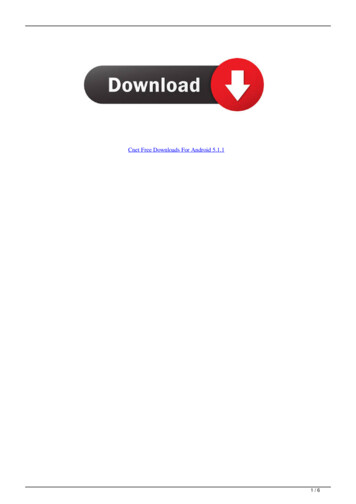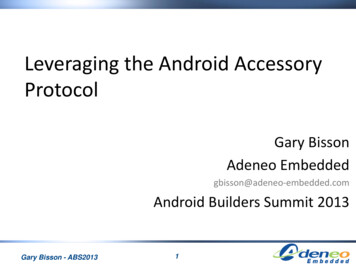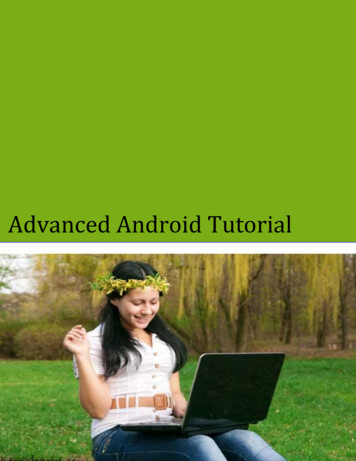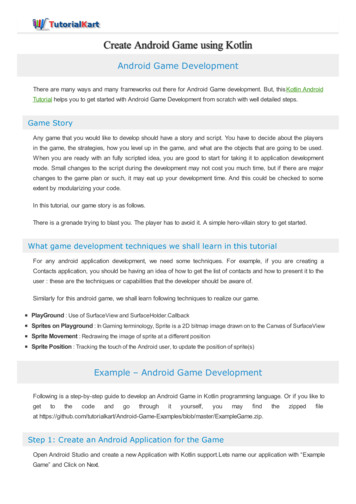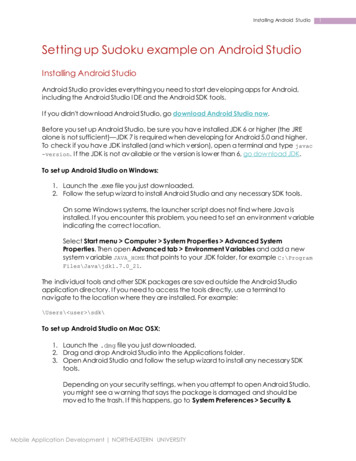
Transcription
Android application development tutorial using java
Java android tutorial. Java app tutorial. Android app tutorial java. Android app development java.Follow us on our fanpages to receive notifications every time there are new articles. Facebook Twitter Are you looking for an online course? These are online courses outside the o7planning website that we introduced, which may include free or discounted courses. Learning MongoDB - A Training Video From Infinite Skills Master Microservices withSpring Boot and Spring Cloud Unity Android Game Development : Build 7 2D & 3D Games Learn NodeJS From Scratch SQL Made Simple: SQL Server Queries for Non-Programmers React with ES6 for Beginners - A Project Included The Complete Android & Java Developer Course - Build 21 Apps Learning Path: Android: App Development withAndroid N The Complete Android App Development Getting Started with Flutter and Firebase Learning Spring Boot Microservices with Spring Cloud Android Internals and Working with the source Start With C / C and Object Oriented Programming Build a Real Time Chat App with JavaScript and Firebase Learn Html5 & CSS3 from scratch MakeAndroid Games within Two Hours! Spring & Hibernate for Beginners (includes Spring Boot) Windows 10 C App Development for Startups - C Simplified Create Android and iOS App using HTML, CSS and JS Beast Android Development: Firebase Necessities JDBC Servlets and JSP - Java Web Development Fundamentals * * The CompleteAndroid Oreo(8.1) , N ,M and Java Development Android and iOS Apps for Your Wordpress Blog Unity 3d Game Development - iOS, Android, & Web - Beginners Scaling Docker on AWS C# Design patterns The complete algorithms course in C# and .Net The Android Crash Course For Beginners to Advanced Android development quick start forbeginners Developing High Quality Android Applications Flutter & Dart - The Complete Guide [2020 Edition] Create Complete Web Applications easily with APEX 5 Servlets and JSPs Tutorial: Learn Web Applications With Java Java Fx Concepts With Practical Examples Learn JavaScript for Web Development Develop Android Apps using Python: KivyNew in Big Data: Hive, HiveMall, AWS Lambda, Solr, Kibana Projects in Android How to create a Flappy Bird inspired iPhone game in Swift 2 Android Development Working With Mysql & PHP(Live on Web) The Complete Android Oreo and Nougat App Tutorials NodeJS in Action Create an Android Game from Scratch using AndEngine Python 2000:Beyond The Basics REST API for beginners - Retrofit and Android Android Beginners Guide To Create A Weather Forecast App Complete guide to install Wordpress, PHP on Cloud,AWS or VPS Android App & Game Development :Build 6 Android Apps & Games Learn React by Building Real Projects JavaFx Tutorial For Beginners Learn AndroidDevelopment From Scratch Ultimate Coding Course for Web App and Android Development Advance Android Programming - learning beyond basics Master MongoDB, the NOSQL leader with Clarity and Confidence Learn Microservices with Spring Boot and Spring Cloud Complete C# Unity Developer 2D: Learn to Code Making Games MySQLdatabase, MySQLi class, Essentials and Much Much More Ruby on Rails 5: Building real world apps for newbies Building User Interface Using React And Flux Create Android & iOS Apps Without Coding Develop Your First 2D Game With Unity3D for Android Full Stack Mobile Developer course ( iOS 11, and Android O ) How to Extract Data fromMultiple Oracle Tables Using SQL Create Web Apps with Meteor & React Learn SSRS SQL Reporting & Business Intelligence Essentials Unity: Learn Android Game Development by recreating games jQuery UI Ultimate:Design Amazing Interfaces Using jQuery UI jQuery Mobile Ultimate : Design amazing apps using jQuery. Build a Complete JQueryPlugin (Image Pop-up Dialog) Introduction To SQL Server Reporting Services -SSRS Absolute Java Basics for Android Spring Framework Development (Java JEE) with AngularJS UI Bootstrap 4 Theme Development Masterclass The Complete Android Material Design Course Java for Intermediate Users Publish Games on Android, iTunes, and GooglePlay with UE4 AWS Administration – Database, Networking, and Beyond Basic Concepts of Web Development, HTTP and Java Servlets Learning Path:Android:Application Development with Android N * * Complete Bootstrap 4 course - build 3 projects iOS 11: The Complete Test-Driven Developer Course Android App Development and Design Becomean iOS/Android Game Developer with Unity 2017 iPhone Programming from Zero to App Store, Swift 4 iOS11 Continuous Delivery on Amazon Web Services (April 2017) Microsoft SQL Server 2012 Certification Training Exam 70-463 C# Programming from Zero to Hero : The Fundamentals Ultimate Ionic 3 - Build iOS and Android Apps with Angular4 The Complete Android Developer Course: Beginner To Advanced! Creating Reports with SQL Server 2012 Reporting Services Responsive Web Design with HTML5 and CSS3 - Introduction Learn Android Programming From Scratch - Basics Python BeautifulSoup: Extract Web Data Beautifully Master Java Web Services and RESTful API with SpringBoot JavaScript projects Welcome to the DOM Useful Code Snippets Learn C by Creating Distributed configuration with Spring Cloud Config Android is an open source and Linux-based operating system for mobile devices such as smartphones and tablet computers. Android was developed by the Open Handset Alliance, led by Google, and othercompanies. This tutorial will teach you basic Android programming and will also take you through some advance concepts related to Android application development. Audience This tutorial has been prepared for the beginners to help them understand basic Android programming. After completing this tutorial you will find yourself at a moderate levelof expertise in Android programming from where you can take yourself to next levels. Prerequisites Android programming is based on Java programming language so if you have basic understanding on Java programming then it will be a fun to learn Android application development. In this codelab, you'll learn how to build and run your first Androidapp in the Java programming language. (If you're looking for the Kotlin version of this codelab, you can go here.) What you must know already This codelab is written for programmers and assumes that you know either the Java or Kotlin programming language. If you are an experienced programmer and adept at reading code, you will likely be able tofollow this codelab, even if you don't have much experience with Java. What you'll learn How to use Android Studio to build your app. How to run your app on a device or in the emulator. How to add interactive buttons. How to display a second screen when a button is pressed. Use Android Studio and Java to write Android apps You write Android appsin the Java programming language using an IDE called Android Studio. Based on JetBrains' IntelliJ IDEA software, Android Studio is an IDE designed specifically for Android development. To work through this codelab, you will need a computer that can run Android Studio 3.6 or higher (or already has Android Studio 3.6 or higher installed). You candownload Android Studio 3.6 from the Android Studio page. Android Studio provides a complete IDE, including an advanced code editor and app templates. It also contains tools for development, debugging, testing, and performance that make it faster and easier to develop apps. You can use Android Studio to test your apps with a large range ofpreconfigured emulators, or on your own mobile device. You can also build production apps and publish apps on the Google Play store. Note: Android Studio is continually being improved. For the latest information on system requirements and installation instructions, see the Android Studio download page. Android Studio is available for computersrunning Windows or Linux, and for Macs running macOS. The OpenJDK (Java Development Kit) is bundled with Android Studio. The installation is similar for all platforms. Any differences are noted below. Navigate to the Android Studio download page and follow the instructions to download and install Android Studio. Accept the defaultconfigurations for all steps, and ensure that all components are selected for installation. After the install is complete, the setup wizard downloads and installs additional components, including the Android SDK. Be patient, because this process might take some time, depending on your internet speed. When the installation completes, Android Studiostarts, and you are ready to create your first project. Troubleshooting: If you run into problems with your installation, see the Android Studio release notes or Troubleshoot Android Studio. In this step, you will create a new Android project for your first app. This simple app displays the string "Hello World" on the screen of an Android virtual orphysical device. Here's what the finished app will look like: What you'll learn How to create a project in Android Studio. How to create an emulated Android device. How to run your app on the emulator. How to run your app on your own physical device, if you have one. Step 1: Create a new project Open Android Studio. In the Welcome to AndroidStudio dialog, click Start a new Android Studio project. Select Basic Activity (not the default). Click Next. Give your application a name such as My First App. Make sure the Language is set to Java. Leave the defaults for the other fields. Click Finish. After these steps, Android Studio: Creates a folder for your Android Studio project called MyFirstApp.
This is usually in a folder called AndroidStudioProjects below your home directory. Builds your project (this may take a few moments). Android Studio uses Gradle as its build system. You can follow the build progress at the bottom of the Android Studio window. Opens the code editor showing your project. Step 2: Get your screen set up When yourproject first opens in Android Studio, there may be a lot of windows and panes open. To make it easier to get to know Android Studio, here are some suggestions on how to customize the layout. If there's a Gradle window open on the right side, click on the minimize button (—) in the upper right corner to hide it. Depending on the size of your screen,consider resizing the pane on the left showing the project folders to take up less space. At this point, your screen should look a bit less cluttered, similar to the screenshot shown below. Step 3: Explore the project structure and layout The upper left of the Android Studio window should look similar to the following diagram: Based on you selecting theBasic Activity template for your project, Android Studio has set up a number of files for you. You can look at the hierarchy of the files for your app in multiple ways, one is in Project view. Project view shows your files and folders structured in a way that is convenient for working with an Android project. (This does not always match the file hierarchy!To see the file hierarchy, choose the Project files view by clicking (3).) Double-click the app (1) folder to expand the hierarchy of app files. (See (1) in the screenshot.) If you click Project (2), you can hide or show the Project view. You might need to select View Tool Windows to see this option. The current Project view selection (3) is Project Android. In the Project Android view you see three or four top-level folders below your app folder: manifests, java, java (generated) and res. You may not see java (generated) right away. Expand the manifests folder. This folder contains AndroidManifest.xml. This file describes all the components of your Android app and is read by the Androidruntime system when your app is executed. 2. Expand the java folder. All your Java language files are organized here. The java folder contains three subfolders: com.example.myfirstapp: This folder contains the Java source code files for your app. com.example.myfirstapp (androidTest): This folder is where you would put your instrumented tests, whichare tests that run on an Android device. It starts out with a skeleton test file. com.example.myfirstapp (test): This folder is where you would put your unit tests. Unit tests don't need an Android device to run. It starts out with a skeleton unit test file. 3. Expand the res folder. This folder contains all the resources for your app, including images, layoutfiles, strings, icons, and styling. It includes these subfolders: drawable: All your app's images will be stored in this folder. layout: This folder contains the UI layout files for your activities. Currently, your app has one activity that has a layout file called activity main.xml. It also contains content main.xml, fragment first.xml, and fragment second.xml.menu: This folder contains XML files describing any menus in your app. mipmap: This folder contains the launcher icons for your app. navigation: This folder contains the navigation graph, which tells Android Studio how to navigate between different parts of your application. values: This folder contains resources, such as strings and colors, used inyour app. Step 4: Create a virtual device (emulator) In this task, you will use the Android Virtual Device (AVD) manager to create a virtual device (or emulator) that simulates the configuration for a particular type of Android device. The first step is to create a configuration that describes the virtual device. In Android Studio, select Tools AVDManager, or click the AVD Manager icon in the toolbar. Click Create Virtual Device. (If you have created a virtual device before, the window shows all of your existing devices and the Create Virtual Device button is at the bottom.) The Select Hardware window shows a list of pre-configured hardware device definitions. Choose a device definition,such as Pixel 2, and click Next. (For this codelab, it really doesn't matter which device definition you pick). In the System Image dialog, from the Recommended tab, choose the latest release. (This does matter.) If a Download link is visible next to a latest release, it is not installed yet, and you need to download it first. If necessary, click the link to startthe download, and click Next when it's done. This may take a while depending on your connection speed. Note: System images can take up a large amount of disk space, so just download what you need. In the next dialog box, accept the defaults, and click Finish. The AVD Manager now shows the virtual device you added. If the Your Virtual DevicesAVD Manager window is still open, go ahead and close it. Step 5: Run your app on your new emulator In Android Studio, select Run Run ‘app' or click the Run icon in the toolbar. The icon will change when your app is already running. If you get a dialog box stating "Instant Run requires that the platform corresponding to your target device (AndroidN.) is installed" go ahead and click Install and continue. In Run Select Device, under Available devices, select the virtual device that you just configured. This menu also appears in the toolbar. The emulator starts and boots just like a physical device. Depending on the speed of your computer, this may take a while. You can look in the smallhorizontal status bar at the very bottom of Android Studio for messages to see the progress. Messages that might appear briefly in the status bar Gradle build running Waiting for target device to come on line Installing APK Launching activity Once your app builds and the emulator is ready, Android Studio uploads the app to the emulator and runs it.You should see your app as shown in the following screenshot. Note: It is a good practice to start the emulator at the beginning of your session. Don't close the emulator until you are done testing your app, so that you don't have to wait for the emulator to boot again. Also, don't have more than one emulator running at once, to reduce memory usage.Step 6: Run your app on a device (if you have one) What you need: An Android device such as a phone or tablet. A data cable to connect your Android device to your computer via the USB port. If you are using a Linux or Windows OS, you may need to perform additional steps to run your app on a hardware device. Check the Run Apps on a HardwareDevice documentation. On Windows, you may need to install the appropriate USB driver for your device. See OEM USB Drivers. Run your app on a device To let Android Studio communicate with your device, you must turn on USB Debugging on your Android device. On Android 4.2 and higher, the Developer options screen is hidden by default. Toshow Developer options and enable USB Debugging: On your device, open Settings About phone and tap Build number seven times. Return to the previous screen (Settings). Developer options appears at the bottom of the list. Tap Developer options. Enable USB Debugging. Now you can connect your device and run the app from Android Studio.Connect your device to your development machine with a USB cable. On the device, you might need to agree to allow USB debugging from your development device. In Android Studio, click Run in the toolbar at the top of the window. (You might need to select View Toolbar to see this option.) The Select Deployment Target dialog opens with the listof available emulators and connected devices. Select your device, and click OK. Android Studio installs the app on your device and runs it. Note: If your device is running an Android platform that isn't installed in Android Studio, you might see a message asking if you want to install the needed platform. Click Install and Continue, then click Finishwhen the process is complete. Troubleshooting If you're stuck, quit Android Studio and restart it. If Android Studio does not recognize your device, try the following: Disconnect your device from your development machine and reconnect it. Restart Android Studio. If your computer still does not find the device or declares it "unauthorized": Disconnectthe device. On the device, open Settings- Developer Options. Tap Revoke USB Debugging authorizations. Reconnect the device to your computer. When prompted, grant authorizations. If you are still having trouble, check that you installed the appropriate USB driver for your device. See the Using Hardware Devices documentation. Check thetroubleshooting section in the Android Studio documentation. Step 7: Explore the app template When you created the project and selected Basic Activity, Android Studio set up a number of files, folders, and also user interface elements for you, so you can start out with a working app and major components in place. This makes it easier to build yourapplication. Looking at your app on the emulator or your device, in addition to the Next button, notice the floating action button with an email icon. If you tap that button, you'll see it has been set up to briefly show a message at the bottom of the screen. This message space is called a snackbar, and it's one of several ways to notify users of your appwith brief information. At the top right of the screen, there's a menu with 3 vertical dots. If you tap on that, you'll see that Android Studio has also created an options menu with a Settings item. Choosing Settings doesn't do anything yet, but having it set up for you makes it easier to add user-configurable settings to your app. Later in this codelab,you'll look at the Next button and modify the way it looks and what it does. Generally, each screen in your Android app is associated with one or more fragments. The single screen displaying "Hello first fragment" is created by one fragment, called FirstFragment. This was generated for you when you created your new project. Each visible fragment inan Android app has a layout that defines the user interface for the fragment. Android Studio has a layout editor where you can create and define layouts. Layouts are defined in XML. The layout editor lets you define and modify your layout either by coding XML or by using the interactive visual editor. Every element in a layout is a view. In this task,you will explore some of the panels in the layout editor, and you will learn how to change property of views. What you'll learn How to use the layout editor. How to set property values. How to add string resources. How to add color resources. Step 1: Open the layout editor Find and open the layout folder (app res layout) on the left side in theProject panel. Double-click fragment first.xml. Troubleshooting: If you don't see the file fragment first.xml, confirm you are running Android Studio 3.6 or later, which is required for this codelab. The panels to the right of the Project view comprise the Layout Editor. They may be arranged differently in your version of Android Studio, but the functionis the same. On the left is a Palette (1) of views you can add to your app. Below that is a Component Tree (2) showing the views currently in this file, and how they are arranged in relation to each other. In the center is the Design editor (3), which shows a visual representation of what the contents of the file will look like when compiled into an Androidapp. You can view the visual representation, the XML code, or both. In the upper right corner of the Design editor, above Attributes (4), find the three icons that look like this: These represent Code (code only), Split (code design), and Design (design only) views. Try selecting the different modes. Depending on your screen size and work style, youmay prefer switching between Code and Design, or staying in Split view. If your Component Tree disappears, hide and show the Palette. Split view: At the lower right of the Design editor you see and - buttons for zooming in and out. Use these buttons to adjust the size of what you see, or click the zoom-to-fit button so that both panels fit on yourscreen. The Design layout on the left shows how your app appears on the device. The Blueprint layout, shown on the right, is a schematic view of the layout. Practice using the layout menu in the top left of the design toolbar to display the design view, the blueprint view, and both views side by side. Depending on the size of your screen and yourpreference, you may wish to only show the Design view or the Blueprint view, instead of both. Use the orientation icon to change the orientation of the layout. This allows you to test how your layout will fit portrait and landscape modes. Use the device menu to view the layout on different devices. (This is extremely useful for testing!) On the right isthe Attributes panel. You'll learn about that later. Step 2: Explore and resize the Component Tree In fragment first.xml, look at the Component Tree. If it's not showing, switch the mode to Design instead of Split or Code. This panel shows the view hierarchy in your layout, that is, how the views are arranged in relation to each other. 2. If necessary,resize the Component Tree so you can read at least part of the strings. 3. Click the Hide icon at the top right of the Component Tree. The Component Tree closes. 4. Bring back the Component Tree by clicking the vertical label Component Tree on the left. Step 3: Explore view hierarchies In the Component Tree, notice that the root of the viewhierarchy is a ConstraintLayout view. Every layout must have a root view that contains all the other views. The root view is always a view group, which is a view that contains other views. A ConstraintLayout is one example of a view group. 2. Notice that the ConstraintLayout contains a TextView, called textview first and a Button, called button first.If the code isn't showing, switch to Code or Split view using the icons in the upper right corner. In the XML code, notice that the root element is . The root element contains a element and a element. Step 4: Change property values In the code editor, examine the properties in the TextView element. Click on the string in the text property, and you'llnotice it refers to a string resource, hello first fragment. android:text "@string/hello first fragment" Right-click on the property and click Go To Declaration or Usages values/strings.xml opens with the string highlighted. Hello first fragment Change the value of the string property to Hello World!. Switch back to fragment first.xml. Selecttextview first in the Component Tree. Look at the Attributes panel on the right, and open the Declared Attributes section if needed. Troubleshooting this step: If the Attributes panel is not visible, click the vertical Attributes label at the top right. In the text field of the TextView in Attributes, notice it still refers to the string resource@string/hello first fragment. Having the strings in a resource file has several advantages. You can change the value of string without having to change any other code. This simplifies translating your app to other languages, because your translators don't have to know anything about the app code. Tip: To find a property in the list of all the properties,click on the magnifying glass icon to the right of Attributes, and begin typing the name of the property. Android Studio will show just the properties that contain that string. Run the app to see the change you made in strings.xml. Your app now shows "Hello World!". Step 5: Change text display properties With textview first still selected in theComponent Tree, in the layout editor, in the list of attributes, under Common Attributes, expand the textAppearance field. (You may need to scroll down to find it.) Change some of the text appearance properties. For example, change the font family, increase the text size, and select bold style. (You might need to scroll the panel to see all the fields.)Change the text color. Click in the textColor field, and enter g. A menu pops up with possible completion values containing the letter g. This list includes predefined colors. Select @android:color/darker gray and press Enter. Below is an example of the textAppearance attributes after making some changes. Look at the XML for the TextView. You seethat the new properties have been added. BottomOf textView. Take a look at the XML code for the button. It now includes the attribute that constrains the top of the button to the bottom of the TextView. app:layout constraintTop toBottomOf "@ id/textview first" You may see a warning, "Not Horizontally Constrained". To fix this, add a constraintfrom the left side of the button to the left side of the screen. Also add a constraint to constrain the bottom of the button to the bottom of the screen. Before adding another button, relabel this button so things are a little clearer about which button is which. Click on the button you just added in the design layout. Look at the Attributes panel on theright, and notice the id field. Change the id from button to toast button. Step 4: Adjust the Next button You will adjust the button labeled Next, which Android Studio created for you when you created the project. The constraint between it and the TextView looks a little different, a wavy line instead of a jagged one, with no arrow. This indicates achain, where the constraints link two or more objects to each other, instead of just one to another. For now, you'll delete the chained constraints and replace them with regular constraints. To delete a constraint: In the design view or blueprint view, hold the Ctrl key (Command on a Mac) and move the cursor over the circle for the constraint until thecircle highlights, then click the circle. Or click on one of the constrained views, then right-click on the constraint and select Delete from the menu. Or in the Attributes panel, move the cursor over the circle for the constraint until it shows an x, then click it. If you delete a constraint and want it back, either undo the action, or create a new constraint.Step 5: Delete the chain constraints Click on the Next button, and then delete the constraint from the top of the button to the TextView. Click on the TextView, and then delete the constraint from the bottom of the text to the Next button. Step 6: Add new constraints Constrain the right side of the Next button to the right of the screen if it isn't already.Delete the constraint on the left side of the Next button. Now constrain the top and bottom of the Next button so that the top of the button is constrained to the bottom of the TextView and the bottom is constrained to the bottom of the screen. The right side of the button is constrained to the right side of the screen. Also constrain the TextView to thebottom of the screen. It may seem like the views are jumping around a lot, but that's normal as you add and remove constraints. Your layout should now look something like this. In the fragment first.xml layout file, find the text property for the toast button button. strings.xml file. Notice that a new string resource has been added, namedtoast button text. . Toast Run the app to make sure it displays as you expect it to. You now know how to create new string resources by extracting them from existing field values. (You can also add new resources to the strings.xml file manually.) And you know how to change the id of a view. Note: The id for a view helps you identify that viewdistinctly from other views. You'll use this later to find particular views using the findViewById() method in your Java code. The Next button already has its text in a string resource, but you'll make some changes to the button to match its new role, which will be to generate and display a random number. As you did for the Toast button, change the idof the Next button from button first to random button in the Attributes panel. If you get a dialog box asking to update all usages of the button, click Yes. This will fix any other references to the button in the project code. In strings.xml, right-click on the next string resource. Select Refactor Rename. and change the name to random button text.Click Refactor to rename your string and close the dialog. Change the val
Java android tutorial. Java app tutorial. Android app tutorial java. Android app development java. . MongoDB, the NOSQL leader with Clarity and Confidence Learn Microservices with Spring Boot and Spring Cloud Complete C# Unity Developer 2D: Learn to Code Making Games MySQL database, MySQLi class, Essentials and Much Much More Ruby on Rails 5 .
